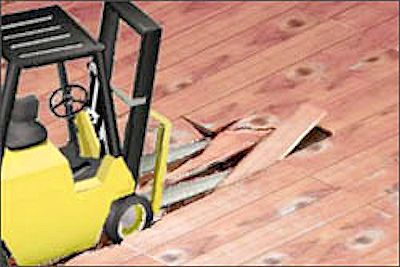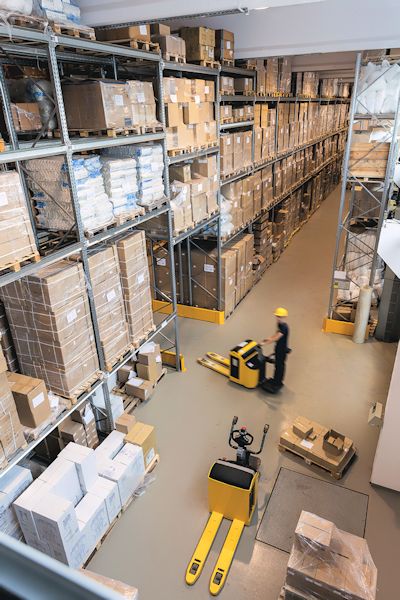Traffic Patterns
The first step to prevent powered industrial truck accidents in a facility is to establish a traffic pattern. This is management's responsibility.
Management must ensure:
- Aisles are well-lighted and free from obstructions.
- Floors are sound and in good shape. Wet, oily or icy surfaces should be avoided. Clean them up as soon as possible.
- Aisles are marked clearly. When they are wide enough for two trucks to pass each other, the center of the aisle and the two extreme edges should be marked with painted lines. In some plants, the aisles are wide enough for two truck lanes and a pedestrian lane.
- Do not allow for two trucks to run side by side in the same direction.
- A truck must never pass another truck at an intersection, blind spot or other dangerous location. In areas where there is high concentration of truck traffic, it may be best to have one-way aisles.
- Speed limits are set and strictly enforced. A few speed limit signs at strategic points serve as constant reminders to truck operations.
- Prominently display stop signs at all crossings. These may be regular stop signs or signs painted or set into the floor. You can also use stripes and discs as indicators.
- Each plant must set up its own rules regarding traffic control, but a required four-way stop at every intersection is a wise way to avoid collisions. Plants that have adopted the four-way stop requirements have found that no significant time is lost by this extra precautionary measure.
Workplace Conditions
Workplace surface and overhead conditions are an important part of safe lift truck operation. Operating surfaces must be strong enough to support the forklift, its load and its operator. They must also be free of holes, grease, oil or obstructions that could cause the lift truck to skid, bounce, and/or possibly tip over.

Workplace surface and overhead conditions and factors to consider when traveling include:
- Slippery Conditions: There is a danger of skidding when traveling on oil, grease, water or other spills. A forklift could tip over when traveling on ice, snow, mud, gravel and uneven areas.
- Obstructions and Uneven Surfaces: There is a danger of tip over when traveling over obstructions, holes and bumps.
- Floor Loading Limits: There is a danger of the floor collapsing if it's unable to support the weight of the forklift, load, and operator.
- Overhead Clearance: There is a chance of damage to lights, stacks, doors, sprinklers and pipes. Damage to the load may also occur, and the forklift may tip over when traveling and hitting an overhead obstruction.
Knowledge Check Choose the best answer for the question.
2-12. When operating powered industrial trucks, which traffic pattern practice should be followed?
You forgot to answer the question!

